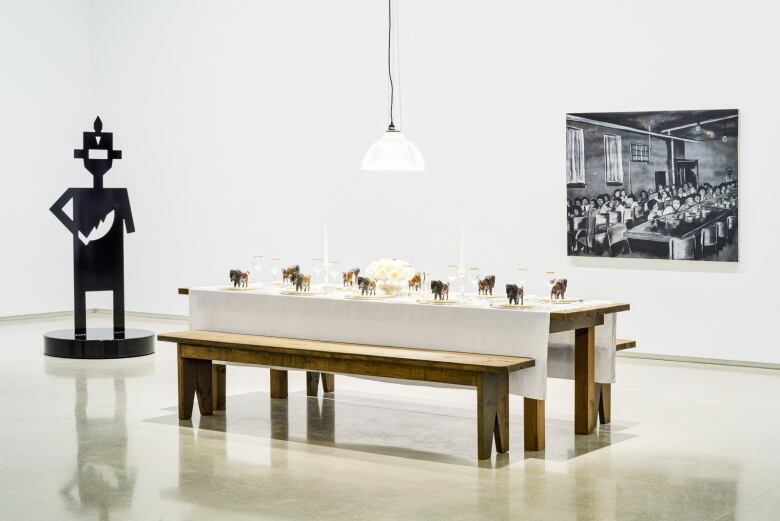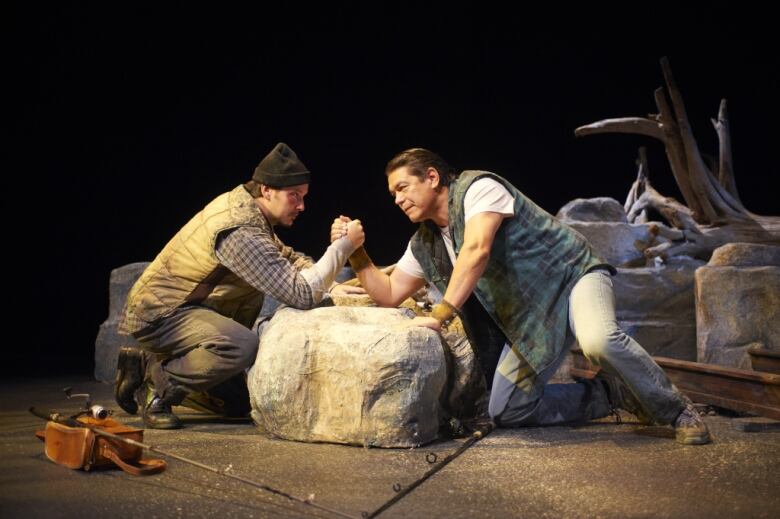10 pieces of art to help you engage with truth and reconciliation
Recommendations from Indigenous artists and curators for films, books, theatre and visual art

To mark the first formally recognized National Day For Truth and Reconciliation, CBC Arts reached out to Indigenous curators and artists with one important question: what pieces of art should Canadians engage with to better under the ideas behind truth and reconciliation?
The answers we got ranged from films to books to works of theatre to specific pieces of visual art. We invite you to spend some time with these works today.
The Ballad of Crowfoot by Willie Dunn

Willie Dunn's 1968 National Film Board short film The Ballad of Crowfoot, often called Canada's first music video, remains one of the most powerful and moving films I've ever seen. Comprised of archival imagery and contemporary newspaper clippings set to Dunn's incantatory song named for the 19th century Siksika Chief who negotiated Treaty 7 on behalf of the Blackfoot Confederacy, it recounts a history of colonial betrayals on the Prairies. The searing imagery brings into relief the devastating effects of the 1800s including the buffalo slaughter and the ravages of disease.
Dunn was a folk singer/activist of Mi'kmaq and Scottish descent whose music is receiving renewed attention with the release of a posthumous double album Creation Never Sleeps, Creation Never Dies: The Willie Dunn Anthology. And his best-known song "I Pity The Country" has been stunningly remade on Michi Saagig Nishnaabeg Leanne Betasamosake Simpson's Polaris-nominated album Theory of Ice.
The Ballad of Crowfoot was the first production by the "Indian Film Crew," part of the NFB's participatory "Challenge For Change" project, created in 1967 with the aim of making activist films for social change. Though the NFB had always had cameras aimed at Indigenous peoples, the directors were white (indeed, these films are illuminating records illustrating colonial attitudes). However, with Dunn's film began an era of representing ourselves. And to this day, Abenaki filmmaker Alanis Obomsawin, who has made over 50 films at the NFB and embodies uncompromising activist filmmaking, continues to inspire us to follow in these footsteps.
Lisa Jackson is an award-winning filmmaker living in Toronto, of mixed Anishinaabe (Aamjiwnaang) and settler descent.
In My Own Moccasins: A Memoir of Resilience by Helen Knott
I read Helen Knott's incredible, life-changing book In My Own Moccasins: A Memoir of Resilience twice — once before I realized I was an addict, and once after. I think that first reading helped me get to the point of realization that sparked the second reading. This book is that powerful. Her story begins with her in a state of withdrawal, as she tries to wrestle herself from the stranglehold of addiction and ground herself back within her body, mind, life and spirit so she can be there for her son, her family and herself.
Knott is a born storyteller, speaking of her highs and lows with the raw emotion, clarity and rhythm of the best blues singers. From her first searing words, we're right there with her: reflecting on her life, rooting her on, soaking up her insights like parched plants soak up water. This book is a memoir of resilience, yes, but it's also a portrait of Indigenous womanhood as power, as the fire that colonialism and Canada can never stamp out.
Alicia Elliott is a Mohawk author and editor. She wrote the book A Mind Spread Out on the Ground.
Angry Inuk by Alethea Arnaquq-Baril
Qimmit: A Clash of Two Truths by Joelie Sanguya and Ole Gjerstad

If you want to better understand how and why we (Inuit and Canada) got to where we are today, I can hardly think of a better use of a few hours of your time than two compelling documentaries that focus on specific histories and their ongoing consequences today: Angry Inuk (2016), directed by Alethea Arnaquq-Baril, and Qimmit: A Clash of Two Truths (2010), directed by Joelie Sanguya and Ole Gjerstad. Of course, there are many films, books, and other resources — including those that focus on the northern residential school and subsequent "day school" systems — that are critical to understanding our shared history, but if you haven't seen these two films, I suggest you start here, because together they powerfully demonstrate the lasting personal and community impacts of the clashing of our cultures under deeply uneven power relations in the Arctic.

Angry Inuk explores how the demonization of the Inuit seal hunt by celebrities, animal rights groups, and other activists has had devastating impacts on the Inuit economy and self-sufficiency, leading to numerous ongoing issues in communities across Inuit Nunangat (the four Inuit regions of Canada). Qimmit follows the investigations of the Qikiqtani Truth Commission on the rapid disappearance of sled dogs, or qimmit, across the Arctic from approximately 1950 to 1970, and the crushing impact of that monumental cultural change from semi-nomadic to sedentary life. Inuit have long held that RCMP deliberately slaughtered sled dogs as part of an effort by the federal government to force Inuit to settle into communities, while RCMP vehemently deny the claim that the shooting of sled dogs was a coordinated effort.
What emerges through both films is an understanding of not only the deep wounds that remain as a result of the rapid colonization of the Arctic in the 20th century, but also the incredible bravery of those Inuit who continue to speak truth to power, and the importance of acknowledging the truth before reconciliation can occur.
Dr. Heather Igloliorte is an Inuk and Newfoundlander from Happy Valley-Goose Bay. She holds the University Research Chair in Circumpolar Indigenous Arts at Concordia University in Montreal, QC.
Sick and Tired, Iini Sookumapi and Aggressive Assimilation by Adrian Stimson

I am a member of the Siksika Nation in southern Alberta whose art looks at numerous issues around residential schools and the history of genocide, given that I have attended two and been affiliated with four overall. My works often evoke melancholy, whimsy, cultural fragility and resilience.
In Sick and Tired (2005), I created an installation that brought the past into the present. I reconfigured material culture from Old Sun Indian Residential school, adding feathers, light and a Bison hide.
In Iini Sookumapi: Guess Who's Coming to Dinner? (2019), I created a dining room table, complete with 10 lavish place settings with an interrogative bison looking at the diner. A light procured from the Old Sun Residential school hangs above. This table and surrounding installation serves a double function: it reconstitutes the conditions under which Siksika Nation members gathered to first consider AA Bronson's A Public Apology to the Siksika Nation, while replicating the table and benches of a residential school dining room.

Aggressive Assimilation (2013) addresses the intergenerational impact of Canada's Indian residential schools had on my family. The triptych is a photograph of the Anglican-run Old Sun Residential School, flanked by portraits of me and my father, myself at the time I first entered residential schools and my father at the time he would have left them. The history of Canada's aggressive assimilationist policies is represented by the Old Sun Residential School dividing me and my father as well as speaking to intergenerational trauma.
Adrian Stimson is a member of the Siksika Nation in southern Alberta. His art looks at numerous issues around residential schools and the history of genocide.
Children of God by Corey Payette
The Mush Hole by Santee Smith
Where the Blood Mixes by Kevin Loring

These plays represent a tiny sampling of the powerful works for the stage by Indigenous artists that tackle this troubling history head on, but there are many other plays that deal with this history and I encourage you to seek them out as well.
Children Of God is Corey Payette's powerful and stirring musical that takes us through the journey of one family on their road to healing. It follows the story of Tommy, who struggles to come to terms with the horrible tragedy of losing his sister Julia to the residential school system. The musical jumps back to their childhood experiences in the residential school and to the present, as Tommy and his mother struggle to heal from their trauma.

The Mush Hole by Santee Smith from Kaha:wi Dance Theatre is a movement-based work that takes us into the struggles of one family as they experience the loss and trauma of their children to the residential school system. It tells the story of a Mohawk family whose children have been taken from their home and forced to attend the Mohawk Institute, known by those who attended it as the Mush Hole because of the awful food they were forced to eat there. The piece explores the impacts on the children as well as the parents, who are left in a community without children to nurture and love. It is an achingly beautiful and provocative story told through the power of dance.

My play Where the Blood Mixes is about the intergenerational impacts of the residential school system on a community and a family. Set in my hometown of Lytton, B.C. (which was most recently in the news after being completely destroyed by fire this summer), the play speaks to struggles, strengths and resilience of the survivors of the Saint George's Residential School in my community. It also deals with surviving suicide, the displacement of Indigenous youth by social services and the very real struggle for those youth to find their way back home to their families and communities.
Kevin Loring is N'lakapamux from the Lytton First Nation. He is the Artistic Director of Indigenous Theatre at the National Arts Centre of Canada and the founding Artistic Director of Savage Production Society in B.C.
Click here for more on CBC's National Day for Truth and Reconciliation programming.
